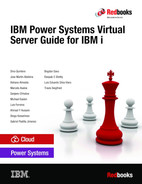Glossary
|
Access Client Solutions (ACS)
Provides a Java-based, platform-independent interface that runs on most operating systems that support Java.
|
|
Ansible
An open-source configuration management and provisioning tool that automates complex applications and provisions resources in the cloud.
|
|
Application Programming Interface (API)
An interface that allows an application program that is written in a high-level language to use specific data or functions of the operating system or another program.
|
|
Aspera
An IBM software product that helps users move critical files and data sets of any size at a maximum speed over your infrastructure and worldwide IP networks.
|
|
Backup and Recovery Media Services (BRMS)
Helps to implement a disciplined approach to managing your backups and provides you with an orderly way to retrieve lost or damaged data.
|
|
Cloud computing
A computing platform where users can access applications or computing resources, as services, from anywhere through their connected devices.
|
|
Cloud native
Refers to how an application is built and deployed. A cloud native application consists of discrete, reusable components that are known as microservices that are designed to integrate into any cloud environment.
|
|
Cloud Object Storage (COS)
A persistent unstructured data storage service format that are spread out across multiple networked systems.
|
|
Cloud service providers (CSPs)
Third-party companies offering a cloud-based platform, including SaaS, PaaS, and IaaS services.
|
|
CloudForms
A management platform to control and manage cloud infrastructures.
|
|
Command Line Interface (CLI)
A computer interface in which the input and output are text based.
|
|
Container
A system construct that allows users to simultaneously run separate logical operating system instances. Containers use layers of file systems to minimize image sizes and promote reuse.
|
|
Dashboard
A user interface component that provides a comprehensive summary of pertinent information from various sources to the user.
|
|
DevOps
A software methodology that integrates application development and IT operations so that teams can deliver code faster to production and iterate continuously based on market feedback.
|
|
Direct Link Connect (DLC)
A protocol layer that is used by nodes on a data link to accomplish an orderly exchange of information.
|
|
Disaster recovery (DR)
IT technologies and best practices that prevent or minimize data loss and business disruption resulted from equipment failures and localized power outages to natural disasters incidents.
|
|
Dynamic Resource Optimization (DRO)
Feature that continuously monitors the resource utilization of physical hosts and virtual machines in a cloud environment.
|
|
Entitled Systems Support (ESS)
A website from IBM to view and manage IBM Power Systems and IBM Storage Systems software and hardware.
|
|
High availability (HA)
The ability of IT services to withstand all outages and continue providing processing capability according to some predefined service level.
|
|
Hybrid cloud
A cloud computing environment that consists of multiple public and private resources.
|
|
Identity and Access Management (IAM)
The process of controlling access of authorized users to data and applications, while helping companies comply with various regulatory requirements.
|
|
Image (Container Image)
A file and its execution parameters that are used within a container runtime to create a container. The file consists of a series of layers, combined at runtime, that are created as the image is built by successive updates.
|
|
Infrastructure as a Service (IaaS)
The delivery of a computer infrastructure, including server, networking, data center, and storage functions as an outsourced service.
|
|
Infrastructure-as-Code (IaC)
Manages and provides an infrastructure through code instead of through manual processes.
|
|
Licensed Program Product (LPP)
It is a licensing scheme for IBM licensed program products.
|
|
Logical Partition (LPAR)
|
|
Managed Service Provider (MSP)
Third-party company that operates day-to-day management services to its customers.
|
|
Multicloud
A cloud adoption strategy that embraces a mix of cloud models (public, dedicated, private, managed) to best meet unique business, application, and workload requirements.
|
|
On-premises
Pertaining to software that is installed and run on the local computers of a user or organization.
|
|
Open Virtual Application (OVA)
An open standard for packaging and distributing virtual appliances.
|
|
Platform as a Service (PaaS)
The delivery of a computing platform, including applications, optimized middleware, development tools, and runtime environments, in a cloud-based environment.
|
|
Pod
A group of containers that are running on a Kubernetes cluster. A pod is a runnable unit of work, which can be a a stand-alone application or a set of microservices.
|
|
Private cloud
A cloud computing environment on which access is limited to members of an enterprise and partner networks.
|
|
Program Temporary Fix (PTF)
A fix approved by IBM and made available to all customers.
|
|
Public cloud
A cloud computing environment on which access to standardized resources, such as infrastructure, multi-tenant hardware, and services, is available to subscribers on a pay-per-use basis.
|
|
Software as a Service (SaaS)
A model of software deployment whereby software including business processes, enterprise applications, and collaboration tools, are provided as a service to customers through the cloud.
|
|
Terraform
An open source “Infrastructure as Code” tool that was created by HashiCorp.
|
|
Virtual machine (VM)
An instance of a data-processing system that appears to be at the exclusive disposal of a single user, but whose functions are accomplished by sharing the resources of a physical data-processing system.
|
|
Virtual Server Instance (VSI)
|
|
Virtual Tape Libraries (VTL)
A hardware component that can emulate a tape library while it uses a disk as the underlying storage hardware.
|
..................Content has been hidden....................
You can't read the all page of ebook, please click here login for view all page.
